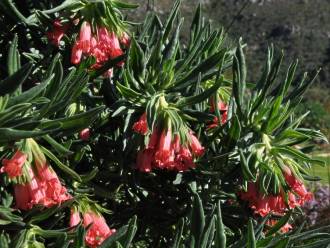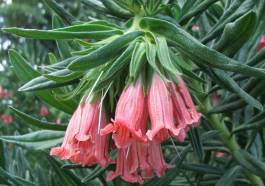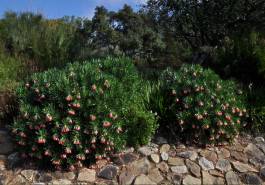Lobostemon belliformis
Lobostemon belliformis (M.H.Buys)
Family: Boraginaceae
Common names: Gouriqua lobostemon (Eng.); Gouriqua agtdaegeneesbos (Afr.)
Introduction
Lobostemon belliformis is an incredibly rare and fabulous shrub from the Borage family; it is spectacular in bloom with its clusters of red tubular flowers.

Description
Description
Lobostemon belliformis is a woody shrub with a thick basal trunk branching freely to form a rounded bright green mound about 2 m wide and up to 1.5 m high. The leaves are long and oval and covered in hairs, giving them a rough texture like a cat's tongue. The flowers are about 30 mm long, tubular and flaring at the mouth. They are arranged in clusters at the ends of the branches giving an impressive display starting in July and continuing until October.

Conservation Status
Status
Only 22 plants of this species were found when it was assessed by the Red List team, and they are restricted to a very small area. More than 80% of its habitat has been lost to mining since 1980 and the remaining area is not conserved. This species is therefore regarded as Critically Endangered.
Distribution and habitat
Distribution description
It is known from only one locality, a sandstone outcrop south of Albertinia near the Gourits River near the southern tip of the Cape Province.
Derivation of name and historical aspects
History
Lobostemon is a South African genus with 31 species mostly found in the fynbos of the Western Cape. The genus name is derived from Latin lobos, meaning lobe, and the Greek word stemon, meaning stamen. J.G.C. Lehmann established the genus in 1830 to separate it from the closely related European genus, Echium. In the Boraginaceae or forget-me-not family, Lobostemon belliformis is also related to the well-known European herbs, comfrey (Symphytum officinale) and borage (Borago officinalis) Myosotis, Anchusa and Cynoglossum.
The specific name 'belliformis' is taken from the Latin 'bella/bellis' meaning beautiful and 'formis' to the form referring to the beautiful flowers of this species (Matt Buys pers. comm.).
Ecology
Ecology
In the wild, Lobostemon belliformis grows in a relatively hot and dry habitat near the coast, surviving summer drought and persistent, strong summer wind. The last remaining population grows on a rocky sandstone outcrop where it escapes fire and can become quite old. The showy and abundant red flowers attract bees and birds, particularly the Orangebreasted and Lesser Doublecollared Sunbirds (Nectarinia violacea and N. chalybea) as well as the Cape Sugarbird (Promerops cafer).
Over time, the plants tend to get very woody with fewer flowers. They re-seed themselves most prolifically after a fire. The seeds are in the form of four little nutlets with spiny tips. Some shrubs may re- prout after fire if not too badly burnt.
Uses
Use
Lobostemon belliformis is closely related to Lobostemon fruticosus which was used by the Khoi, the settlers and Malays. A tea made of the leaves, if drunk first thing in the morning, was said to be a sure cure for ringworm in humans and animals--hence the Afrikaans common name, douwurmbos. The name agtdaegeneesbossie, meaning eight-day-healing-bush, refers to the belief that this plant could heal all sorts of ailments within eight days. Lobostemon belliformis is however so rare and in such a remote locality that it was probably not used for traditional medicinal purposes.
Lobostemon belliformis is relatively new to horticulture where it is used at Kirstenbosch as informal plantings mainly in fynbos displays. It has been available in small quantities at the Annual Plant Fair and the Kirstenbosch Garden shop.

Growing Lobostemon belliformis
Grow
Lobostemon belliformis grows best in a warm, sunny position in sandy well-drained soils and particularly in rockeries and on embankments. It is not cold-tolerant and will need protection from frost. In the Cape the best time to plant is during the rainy months of winter to allow plants to establish themselves before the warm, dry summers. It has performed very well at Kirstenbosch providing very showy displays from winter into spring. It will benefit from some top dressing around the plant with compost once a year. Sometimes old plants begin to lose their leaves and may even die. When plants begin to lose condition, prune back one-third and dress with compost. They may be saved by this intervention and re-sprout from the older wood. If the plants die, there are invariably some seeds that will germinate and grow vigorously, replacing the old plant.
Cuttings from the tips of branches do not root well. They should be taken from the spindly side shoots re-sprouting from the older wood, in the middle of the bush, in either spring or autumn. The cuttings should not be kept too wet, as they may turn black and rot easily. Cuttings rooted in 50:50 milled bark and polystyrene on bottom heat grow best.
Plants grow from fresh seeds collected when the old flower heads turn brownishgrey. Treat seed with hot water and thereafter with smoke to aid germination.
References
- Buys, M.H. 2006. A morphological cladistic analysis of Lobostemon (Boraginaceae). South African Journal of Botany 72: 383-390.
- Goldblatt, P. & Manning, J. 2000. Cape plants. A conspectus of the Cape flora of South Africa. Strelitzia 9. National Botanical Institute, Pretoria.
- Roberts, M. 1990. Indigenous healing plants. Southern Book Publishers, Pretoria.
- Raimondo, D. et al. 2009. Red List of South African Plants. Strelitzia 25. South African National Botanical Institute, Pretoria.
- Smith, T. 2003. Guide to plant genera of southwestern Cape. University of Cape Town, Cape Town.
- Van Wyk, B-E., Van Oudtshoorn, B. & Gericke, N. 1997. Medicinal plants of South Africa. Briza Publications, Pretoria.
Credits
Anthony Hitchcock
Kirstenbosch National Botanical Garden
August 2011
Plant Attributes:
Plant Type: Shrub
SA Distribution: Western Cape
Soil type: Sandy
Flowering season: Spring, Early Summer, Winter
PH: Acid, Alkaline, Neutral
Flower colour: Red
Aspect: Full Sun
Gardening skill: Average
Special Features:
Horticultural zones







Rate this article
Article well written and informative
Rate this plant
Is this an interesting plant?
Login to add your Comment
Back to topNot registered yet? Click here to register.